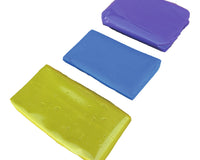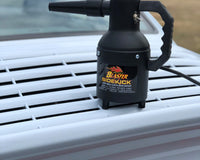Protecting your car's interior is as crucial as maintaining its exterior. The application of fabric and leather coatings can extend the lifespan and appearance of your car's upholstery, preventing wear and tear while maintaining a clean, fresh look. This article explores the benefits of using these coatings, the application process, and tips for long-term care to keep your car's interior in pristine condition.
Understanding Fabric and Leather Coatings
Fabric and leather coatings are specialised products designed to create a protective barrier on interior surfaces. These coatings help repel liquids, resist stains, and protect against UV damage, thereby preserving the material's integrity and appearance over time.
What are Fabric Coatings?
Fabric coatings, also known as fabric protectors, are typically applied to cloth seats, carpets, and fabric headliners. They work by forming a thin, invisible layer that prevents dirt, water, and stains from penetrating the fibres. This barrier makes cleaning easier and helps maintain the fabric’s original colour and texture. Fabric coatings are often water-based and safe to use on most types of automotive fabrics.
What are Leather Coatings?
Leather coatings are designed to protect leather seats and trim from spills, stains, and UV damage. Unlike traditional leather conditioners that nourish the material, leather coatings create a protective layer that prevents contaminants from seeping into the leather’s pores. This helps maintain the leather's appearance, reduces the risk of cracking or fading, and makes cleaning more straightforward. Leather coatings can be either water-based or solvent-based, each offering different levels of protection and durability.
Benefits of Using Fabric Coatings
Applying fabric coatings to your car’s upholstery offers several advantages that go beyond merely keeping it clean. These coatings enhance the durability of the fabric, making it more resistant to everyday wear and tear.
Enhanced Stain Resistance
One of the primary benefits of fabric coatings is their ability to repel stains. Spills from beverages, food, and other liquids can quickly penetrate unprotected fabric, leading to difficult-to-remove stains. Fabric coatings act as a barrier, preventing these substances from absorbing into the fibres and making it easier to clean up spills without leaving marks. This is particularly beneficial for families with children or for those who frequently transport pets.
Protection Against UV Damage
Fabric coatings also offer protection against UV rays, which can cause fabric to fade and weaken over time. The coating helps to block UV radiation, preserving the fabric’s colour and preventing the material from becoming brittle. This is essential for maintaining the aesthetic appeal of your car’s interior, especially in regions with intense sunlight.
Long-Term Durability
By applying a fabric coating, you enhance the fabric's resistance to everyday wear and tear. The coating helps reduce abrasion and friction, which can cause the fabric to wear thin or tear over time. This extends the life of your car’s upholstery, making it a worthwhile investment for long-term care.
Benefits of Using Leather Coatings
Leather coatings provide a range of benefits that help maintain the luxury and comfort of leather interiors. They protect the material from environmental and chemical damage, ensuring it remains supple and attractive.
Prevention of Cracking and Fading
Leather is prone to cracking and fading when exposed to sunlight and varying temperatures. Leather coatings provide a protective layer that shields the surface from UV rays and environmental pollutants, reducing the risk of damage. This helps maintain the leather’s suppleness and colour, preventing it from becoming dry, brittle, and discoloured.
Easier Cleaning and Maintenance
Leather coatings make cleaning easier by preventing dirt and grime from penetrating the leather's surface. Spills and stains can be wiped away more easily, reducing the need for aggressive cleaning agents that might otherwise damage the leather. This simplifies the maintenance routine and helps keep the leather looking new for longer.

Preservation of Leather Texture
Leather coatings help maintain the natural texture of the leather by protecting it from wear and abrasion. The coating forms a thin barrier that reduces friction, preventing the leather from becoming smooth and shiny in high-use areas. This preserves the original feel and appearance of the leather, ensuring that it remains soft and comfortable.
How to Apply Fabric Coatings
Applying fabric coatings is a straightforward process that can be done at home with the right products and tools. Following proper application techniques ensures maximum protection and longevity of the coating.
Preparing the Surface
Before applying a fabric coating, it's essential to clean the surface thoroughly. Vacuum the fabric to remove loose dirt and debris, and use a fabric cleaner to address any existing stains. Allow the fabric to dry completely before applying the coating. This preparation step ensures that the coating adheres properly and provides the best protection.
Applying the Coating
Spray the fabric coating evenly across the surface, holding the nozzle at a recommended distance (usually about 15-20 cm). Apply in a sweeping motion to ensure even coverage, and avoid saturating any particular area. Some coatings may require a second application for maximum effectiveness. Follow the manufacturer's instructions regarding drying times and additional coats.
Post-Application Care
After applying the fabric coating, allow it to dry completely before using the car. This can take several hours to overnight, depending on the product used. Avoid spilling liquids on the fabric until the coating has fully cured. Regularly vacuum and clean the fabric to maintain its appearance and prolong the life of the coating.
How to Apply Leather Coatings
Applying leather coatings requires a bit more care due to the sensitive nature of leather. Proper preparation and application techniques help ensure the coating provides effective protection without harming the leather.
Cleaning the Leather
Start by cleaning the leather surface using a leather cleaner or mild soap solution. Use a soft cloth to remove dirt, oils, and previous treatments from the leather. Ensure the leather is completely dry before applying the coating. This step is crucial as it ensures the coating adheres properly and provides the intended protection.
Applying the Leather Coating
Apply the leather coating using a clean, soft cloth or applicator pad. Spread the product evenly across the surface, working it into the leather in a circular motion. Be sure to cover all areas, including seams and crevices. Allow the coating to dry according to the manufacturer's instructions. Some products may require buffing with a dry cloth after application to remove any excess and ensure an even finish.
Curing and Maintenance
After applying the leather coating, allow it to cure fully before using the car. This may take a few hours to overnight. Once cured, the coating will provide a protective barrier against spills and stains. Regularly clean the leather with a gentle cleaner and avoid using harsh chemicals or abrasive tools that could damage the coating.
Choosing the Right Coatings
Selecting the right fabric and leather coatings is essential for achieving the best results. Various products offer different levels of protection, so it’s important to choose ones that suit your specific needs and preferences.
Factors to Consider for Fabric Coatings
When choosing fabric coatings, consider factors such as ease of application, durability, and the type of fabric in your car. Water-based coatings are generally safer and less likely to alter the fabric’s feel or colour. Look for products that offer UV protection and stain resistance for the best results. Reading product reviews and seeking recommendations can also help in selecting effective fabric coatings.
Factors to Consider for Leather Coatings
For leather coatings, consider the type of leather in your car and the level of protection required. Water-based leather coatings are typically more environmentally friendly and less likely to alter the leather’s appearance. Solvent-based coatings may offer more durable protection but require more careful application. Ensure the product you choose is suitable for automotive leather and provides UV protection to prevent fading and cracking.
Maintaining Coated Interiors
Proper maintenance of coated interiors involves regular cleaning and periodic reapplication of the coatings to ensure ongoing protection. This helps maintain the appearance and durability of the fabric and leather surfaces.
Routine Cleaning
For fabric surfaces, vacuum regularly to remove dirt and debris that can wear down the coating. Spot clean any spills or stains promptly using a gentle fabric cleaner. For leather, use a soft cloth to wipe away dust and dirt, and clean with a leather cleaner as needed. Avoid using harsh chemicals or abrasive tools that could damage the coatings.
Reapplication of Coatings
Over time, the protective properties of fabric and leather coatings can diminish, especially in high-use areas. Reapply the coatings periodically to maintain their effectiveness. Follow the manufacturer's recommendations for reapplication intervals, which can vary depending on the product and usage. Regular reapplication helps ensure that your car's interior remains protected and in good condition.
Dealing with Stains and Spills
Even with protective coatings, stains and spills can still occur. Knowing how to address these incidents promptly can prevent long-term damage and keep your car’s interior looking clean.
Tackling Fabric Stains
For fabric stains, blot the area with a clean, dry cloth to absorb as much liquid as possible. Avoid rubbing, which can push the stain deeper into the fibres. Apply a fabric cleaner or a mild soap solution to the stain and blot gently. Rinse with clean water and blot dry. Allow the area to dry completely before applying a touch-up coat of fabric protector if needed.
Managing Leather Spills
For leather spills, wipe away the excess liquid with a clean cloth immediately. Avoid using excessive water or harsh cleaners, which can damage the leather. Use a leather cleaner to gently clean the affected area and allow it to dry. Apply a leather conditioner or a touch-up coat of leather protector to restore the protective barrier.
Addressing Wear and Tear
Despite the best efforts, wear and tear on fabric and leather interiors can occur over time. Addressing these issues promptly can help maintain the appearance and comfort of your car's interior.
Repairing Fabric Damage
For minor fabric damage, such as small tears or fraying, use a fabric repair kit or seek professional upholstery repair services. Addressing these issues early can prevent them from worsening and extend the life of the fabric. Regularly inspect the fabric for signs of wear and apply protective coatings as needed to maintain its durability.
Fixing Leather Wear
For leather, minor scuffs and scratches can often be repaired using leather repair kits or touch-up products. For more significant damage, consider professional leather repair services. Regular conditioning and reapplication of leather coatings can help prevent wear and keep the leather looking its best.
Conclusion
Using fabric and leather coatings for long-term care is an effective way to protect your car’s interior from stains, UV damage, and wear. These coatings provide a durable barrier that preserves the appearance and longevity of fabric and leather surfaces, making maintenance easier and enhancing the overall aesthetic of your vehicle. By choosing the right products, applying them correctly, and maintaining them regularly, car enthusiasts can enjoy a well-protected and beautiful interior that stands the test of time.




